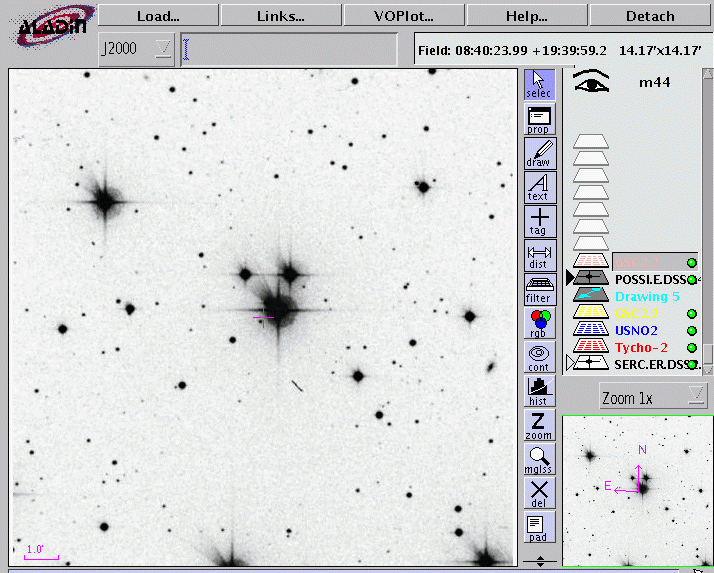
Following last night's tests of several video cameras, I did some more. The contestants tonight are
The first two provide analog video output which I digitized with a PCMCIA card on a Windows 98 laptop; the ToUCam has a USB interface which I plugged into an iBook.
As on the previous night, I used the RIT Observatory's 16-inch f/15 classical cassegrain telescope, and didn't spend too much time focusing. I suspect that it's time for me to re-collimate the telescope...
The night was clear, but bright, with a first quarter moon interfering with my images. It was less windy than the previous night, though, and the seeing was somewhat better. I wanted to get images of stars in M44, so I got started early.
I started by going to M44, which was pretty low in the west at sunset: it was at airmass 1.61 at 9:00 PM and 2.16 at 10:00 PM. Near its center is a set of three bright stars:

I'm going to zoom in a bit. For the marked stars, I have magnitudes from the Tycho-2 and GSC catalogs.
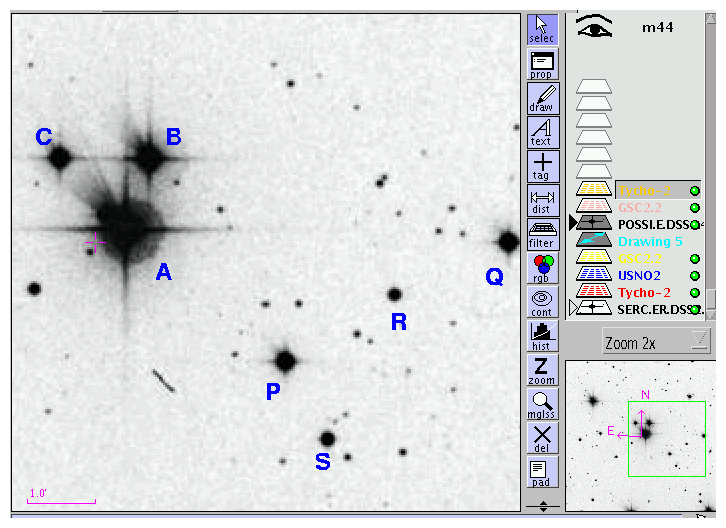
Star Tycho-2 GSC2.2 UCAC mag
Bt Vt F (red) "Vish"
-------------------------------------------------
A 7.7 6.5
B 7.9 7.6
C 9.7 9.2
D 10.3
P 10.6 9.9 9.6
Q 10.3 10.0 9.5
R 12.3
S 11.6
--------------------------------------------------
Stars A and B are 63.35 arcseconds apart.
First was the Astrovid 2000. I set the shutter to its longest exposure and the gain to maximum. Here's a sample image in its original form, which is rotated 90 degrees clockwise so that North is right and East is up:
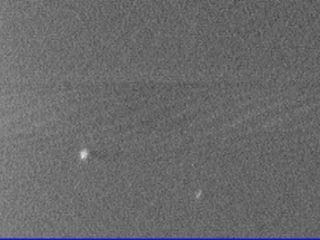
This is the orientation of all my video images if I place the camera so that its top surface points away from the mounting plate of our german equatorial mount. From now on, I'll rotate the images to match the standard orientation, like so:
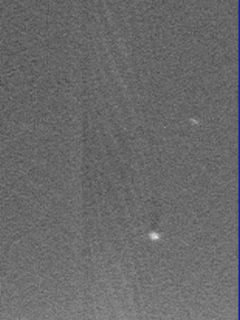
So, in this image, star A is easily seen, star B is clear but faint, and star C can barely been discerned above the noise. During the night, I could pick it out on the video monitor pretty easily; apparently, the digitization process loses some signal or adds some noise (and also doesn't allow the eye to integrate over several consecutive frames). One might summarize by placing the Astrovid's limiting magnitude in my setup somewhere between 8.5 and 9.5.
Stars A and B are separated by 122.7 pixels, which yields a plate scale of about 0.52 arcsec per pixel. That's close enough to last night's value (0.53 arcsec per pixel) for me.
I then replaced the Astrovid 2000 with our new PC164C video camera. Here's an image (rotated to North up, East right):
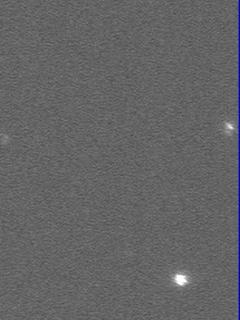
Star A is saturated, star B is not saturated, and star C can be seen easily near the left (east) edge. There is a faint star to the upper-left (east-northeast) of star A which appears in the charts and can be very faintly glimpsed in this image. It was easier to see on the video monitor last night. This star has a magnitude of 10.3 in the UCAC2 catalog, in a bandpass somewhere between V and R.
The separation of stars A and B is 161.0 pixels, yielding a plate scale of 0.39 arcseconds per pixel, matching last night's determination.
I moved the telescope to the west to see if I could detect the fainter stars P, Q, R, S. I was able to find stars P and Q. Here's an image of star P, at magnitude Vt=9.9; it is down near the bottom-left corner of the frame.
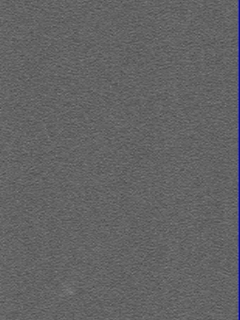
Star Q looked similarly faint on the monitor last night. I wasn't able to detect stars S or R.
I'd put the limiting magnitude of the PC164C with this setup at around 10 to 10.5.
Tracy Davis (who was using the RIT Observatory's 12-inch telescope to measure the light curve of an asteroid) helped me to see if the DIP switches on the back of the PC164C had any effect on its performance. There are two switches:
The unit was shipped with pins at positions "E/S" and "DC". While pointing at stars A, B, C, we tried switching one at a time, then both together, but saw no obvious difference in the image.
Finally, I put the ToUCam on the telescope. By this time, M44 was very low in the sky, at an airmass above 2.5, so I didn't want to use it for a test. After flailing pointlessly for a target, I settled on theta Virginis, aka 51 Vir = HD 114330 = HR 4963 = TYC 4963-1316-1 = Struve 1724. With the shutter set to its slowest speed and the gain to its maximum value, I grabbed several images with size 320x240 pixels. Here's one, again rotated so that North is up, East to the left:
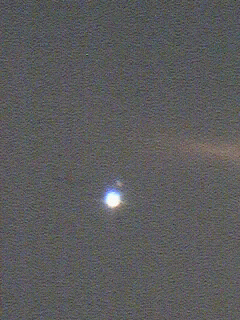
The brighter component of this double is itself a very close double star. According to Brummellaar et al. (AJ 119, 2403 [2000]), there are two components of magnitudes V=4.5 and V=6.7 with a separation of 0.45 arcseconds at position angle 336 degrees; that would be to the upper-right in this image. The fainter star was measured by O. E. Ferrer in 1980 to be 7.5 arcseconds away from the primary and to be about 3.7 magnitudes fainter. Given the primary's combined magnitude of V=4.4, that would make the secondary about V=8.1. The apparent separation of 16.8 pixels means that the ToUCam has a plate scale of about 0.45 arcseconds per pixel, and a field of view of 143x107 arcseconds (or 2.4x1.8 arcminutes).
I can guess that the ToUCam might detect stars down to magnitude 9 or so, but I'll need to make further tests to be sure.
Putting tonight's results together with those from last night, I now can say that with a 16-inch f/15 cassegrain,
Camera pixel size field of view limiting mag
(arcseconds) (arcseconds) (very rough)
--------------------------------------------------------------
Astrovid PlanetCam 0.29 94 x 71 6
Astrovid 2000 0.53 168 x 126 8-9
SuperCircuits PC164C 0.39 125 x 94 10-11
ToUCam 0.45 143 x 107 9
--------------------------------------------------------------